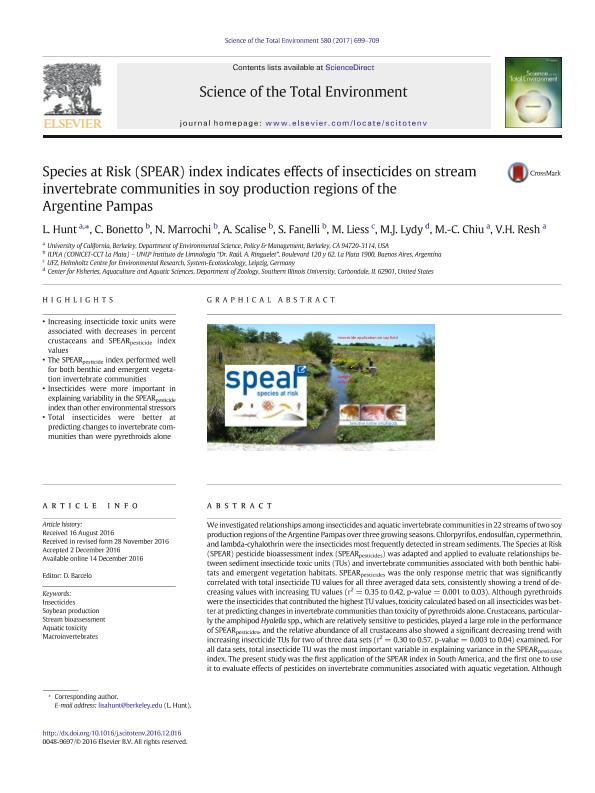Mostrar el registro sencillo del ítem
dc.contributor.author
Hunt, Lisa

dc.contributor.author
Bonetto, Carlos Alberto

dc.contributor.author
Marrochi, María Natalia

dc.contributor.author
Scalise, Ana Maria

dc.contributor.author
Fanelli, Silvia Laura

dc.contributor.author
Liess, M.
dc.contributor.author
Lydy, Michael J.

dc.contributor.author
Chiu, M. C.
dc.contributor.author
Resh, Vincent H.

dc.date.available
2018-12-03T15:21:25Z
dc.date.issued
2017-02
dc.identifier.citation
Hunt, Lisa; Bonetto, Carlos Alberto; Marrochi, María Natalia; Scalise, Ana Maria; Fanelli, Silvia Laura; et al.; Species at Risk (SPEAR) index indicates effects of insecticides on stream invertebrate communities in soy production regions of the Argentine Pampas; Elsevier Science; Science of the Total Environment; 580; 2-2017; 699-709
dc.identifier.issn
0048-9697
dc.identifier.uri
http://hdl.handle.net/11336/65580
dc.description.abstract
We investigated relationships among insecticides and aquatic invertebrate communities in 22 streams of two soy production regions of the Argentine Pampas over three growing seasons. Chlorpyrifos, endosulfan, cypermethrin, and lambda-cyhalothrin were the insecticides most frequently detected in stream sediments. The Species at Risk (SPEAR) pesticide bioassessment index (SPEARpesticides) was adapted and applied to evaluate relationships between sediment insecticide toxic units (TUs) and invertebrate communities associated with both benthic habitats and emergent vegetation habitats. SPEARpesticides was the only response metric that was significantly correlated with total insecticide TU values for all three averaged data sets, consistently showing a trend of decreasing values with increasing TU values (r2 = 0.35 to 0.42, p-value = 0.001 to 0.03). Although pyrethroids were the insecticides that contributed the highest TU values, toxicity calculated based on all insecticides was better at predicting changes in invertebrate communities than toxicity of pyrethroids alone. Crustaceans, particularly the amphipod Hyalella spp., which are relatively sensitive to pesticides, played a large role in the performance of SPEARpesticides, and the relative abundance of all crustaceans also showed a significant decreasing trend with increasing insecticide TUs for two of three data sets (r2 = 0.30 to 0.57, p-value = 0.003 to 0.04) examined. For all data sets, total insecticide TU was the most important variable in explaining variance in the SPEARpesticides index. The present study was the first application of the SPEAR index in South America, and the first one to use it to evaluate effects of pesticides on invertebrate communities associated with aquatic vegetation. Although the SPEAR index was developed in Europe, it performed well in the Argentine Pampas with only minor modifications, and would likely improve in performance as more data are obtained on traits of South American taxa, such as pesticide sensitivity and generation time.
dc.format
application/pdf
dc.language.iso
eng
dc.publisher
Elsevier Science

dc.rights
info:eu-repo/semantics/openAccess
dc.rights.uri
https://creativecommons.org/licenses/by-nc-sa/2.5/ar/
dc.subject
Aquatic Toxicity
dc.subject
Insecticides
dc.subject
Macroinvertebrates
dc.subject
Soybean Production
dc.subject
Stream Bioassessment
dc.subject.classification
Meteorología y Ciencias Atmosféricas

dc.subject.classification
Ciencias de la Tierra y relacionadas con el Medio Ambiente

dc.subject.classification
CIENCIAS NATURALES Y EXACTAS

dc.title
Species at Risk (SPEAR) index indicates effects of insecticides on stream invertebrate communities in soy production regions of the Argentine Pampas
dc.type
info:eu-repo/semantics/article
dc.type
info:ar-repo/semantics/artículo
dc.type
info:eu-repo/semantics/publishedVersion
dc.date.updated
2018-10-22T22:00:12Z
dc.journal.volume
580
dc.journal.pagination
699-709
dc.journal.pais
Países Bajos

dc.journal.ciudad
Amsterdam
dc.description.fil
Fil: Hunt, Lisa. University of California at Berkeley; Estados Unidos
dc.description.fil
Fil: Bonetto, Carlos Alberto. Consejo Nacional de Investigaciones Científicas y Técnicas. Centro Científico Tecnológico Conicet - La Plata. Instituto de Limnología "Dr. Raúl A. Ringuelet". Universidad Nacional de La Plata. Facultad de Ciencias Naturales y Museo. Instituto de Limnología; Argentina
dc.description.fil
Fil: Marrochi, María Natalia. Consejo Nacional de Investigaciones Científicas y Técnicas. Centro Científico Tecnológico Conicet - La Plata. Instituto de Limnología "Dr. Raúl A. Ringuelet". Universidad Nacional de La Plata. Facultad de Ciencias Naturales y Museo. Instituto de Limnología; Argentina
dc.description.fil
Fil: Scalise, Ana Maria. Consejo Nacional de Investigaciones Científicas y Técnicas. Centro Científico Tecnológico Conicet - La Plata. Instituto de Limnología "Dr. Raúl A. Ringuelet". Universidad Nacional de La Plata. Facultad de Ciencias Naturales y Museo. Instituto de Limnología; Argentina
dc.description.fil
Fil: Fanelli, Silvia Laura. Consejo Nacional de Investigaciones Científicas y Técnicas. Centro Científico Tecnológico Conicet - La Plata. Instituto de Limnología "Dr. Raúl A. Ringuelet". Universidad Nacional de La Plata. Facultad de Ciencias Naturales y Museo. Instituto de Limnología; Argentina
dc.description.fil
Fil: Liess, M.. Helmholtz Centre for Environmental Research; Alemania
dc.description.fil
Fil: Lydy, Michael J.. Southern Illinois University; Estados Unidos
dc.description.fil
Fil: Chiu, M. C.. University of California at Berkeley; Estados Unidos
dc.description.fil
Fil: Resh, Vincent H.. University of California at Berkeley; Estados Unidos
dc.journal.title
Science of the Total Environment

dc.relation.alternativeid
info:eu-repo/semantics/altIdentifier/doi/https://dx.doi.org/10.1016/j.scitotenv.2016.12.016
dc.relation.alternativeid
info:eu-repo/semantics/altIdentifier/url/https://www.sciencedirect.com/science/article/pii/S0048969716327012
Archivos asociados
